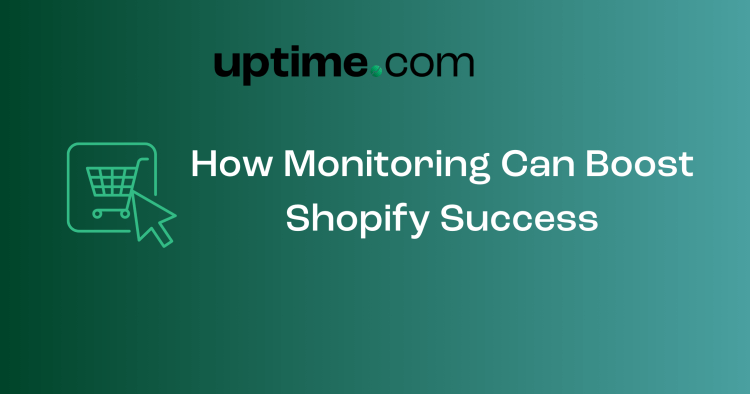
4 Ways That Reseller Monitoring Catalyzes Shopify Success
Stuck in a sales slump? Any seasoned reseller can tell you that there comes a time for any growing business when you’ve poured your heart into attracting customers and perfecting the shopping experience, only to see your sales numbers stagnate.
It’s absolutely maddening but certainly not unmanageable.
Sometimes, it’s not about the marketing or the product—it’s all about site performance. When your site runs smoothly, sales follow, and site performance monitoring reveals hidden issues currently holding you up.
Let’s examine four ways to overcome your plateau by addressing site performance issues, with tips tailored specifically to Shopify resellers.
Capture More Sales With a High-Performing Mobile Site
Your first priority should always be mobile optimization. It’s a complete non-negotiable. Why, you ask?
First, Google’s mobile-first indexing practices mean that their site crawlers almost exclusively rely on the mobile version of a site for their rankings rather than the desktop site. Second, in the first quarter of 2024, Statista found that three-fourths of retail site visits in the U.S. came from smartphones, accounting for two-thirds of all online shopping orders.
If you don’t want to miss out on the bulk of e-commerce traffic, you must invest in site performance monitoring services that give insights into the mobile version of your Shopify store:
- Your site should be mobile responsive, automatically adjusting to fit any screen size.
- Identify elements that slow down your mobile site, such as large images or heavy scripts, and optimize them specifically for mobile users. This practice also applies to using adaptive images determined by the device.
- To reduce load times on mobile devices, use smaller, compressed images. Consider using modern image formats like WebP, which offer better compression without losing quality.
- Reduce the number of requests the browser makes to load your page by reducing redirects and removing unnecessary elements.
- Keep top-of-fold practices in mind. Your visitors should see the most important UI and UX elements without scrolling first.
Optimize Your Product Pages
Online shoppers expect the websites they frequent to have a snappy load speed, and Shopify has the numbers to back that up. A recent blog post noted, “The average conversion rate for an ecommerce store decreases by 0.3% for every additional second it takes for your website to load.”
Not only are slow load times putting your current customer base at risk, but they’re also dragging down your potential for attracting new ones. Google’s ranking algorithm prioritizes speedy sites, so fewer people will find your store in their organic search results if you’re running behind your competitors.
Performance monitoring tools can help you spot the slowdowns, while these tips are a good place to start for improving page load times:
- Large product images take longer to load, so compress them using tools like Optimole and ShortPixel to speed up your site without sacrificing photo quality.
- Let browsers store some of your site’s data so returning visitors experience faster load times.
- Are you still using the same server package you used when opening your reseller store? If so, that might be the problem. If necessary, upgrade your hosting plan to handle more traffic.
- Speaking of server issues, invest in a hosting service that uses a Content Delivery Network (CDN) to distribute your content across multiple global servers. Then, your customers can get the same consistently quick load times regardless of where they’re browsing from.
- Lazy load your images and videos. Doing so only loads your media content when needed, so your visitors can see whichever page they’ve landed on faster.
Reduce Your Cart Abandonment Rates
Cart abandonment is the bane of any Shopify reseller’s existence because it means you were this close to closing a sale before something went wrong. On top of that, cart abandonment rates are surprisingly high—around 70.19%. So, while it’s practically impossible to avoid cart abandonment altogether, reducing the number of frustrations and complications your customers experience when they finish a purchase can help.
- Reduce the number of fields customers need to fill out. The more streamlined your forms are, the faster they’ll load, and the more likely customers will fill them out without getting irritated.
- Server speed can also affect how long it takes for your checkout page to process and confirm the purchase. Monitor your server performance metrics to determine when it’s time to upgrade.
- A shorter, more straightforward checkout process reduces load times and performance stress on each step, making the process faster.
- Performance monitoring can detect delays in payment gateway integrations, ensuring your customers can move from point A to point B without stalling.
Provide Your Customers With Consistent Performance During High Traffic
High-traffic periods can be a blessing and a curse. While they offer great sales opportunities, they can also strain your website and increase the load on your servers. The last thing you want when your customers are flooding in is for site speed to slow to a crawl or, worse yet, cause your website to go down altogether. With the right performance monitoring tools, you can better prepare for sustainable scalability to handle an ever-growing customer base:
- Distribute incoming traffic across multiple servers to prevent any single server from becoming overwhelmed
- Consider cloud-based services that automatically scale resources in response to manage traffic surges
- Set up real-time alerts, so you know when something’s gone wrong
- Quickly communicate updates about unexpected outages with incident management status pages
Interested in catalyzing your Shopify success? Uptime.com has your back.
We offer full-scale site performance monitoring tools, now with real-time monitoring for Shopify. With our help, you can swiftly resolve problems, giving your customers the smooth experience they’ve come to expect.
See what Uptime.com can do for you by requesting a free 14-day trial!
Minute-by-minute Uptime checks.
Start your 14-day free trial with no credit card required at Uptime.com.
 Uptime.com Blog
Uptime.com Blog


